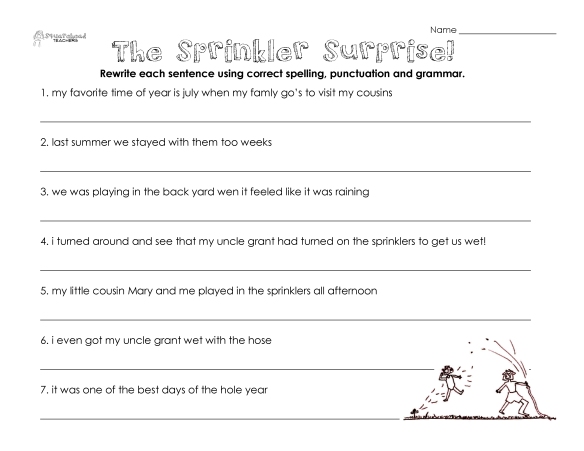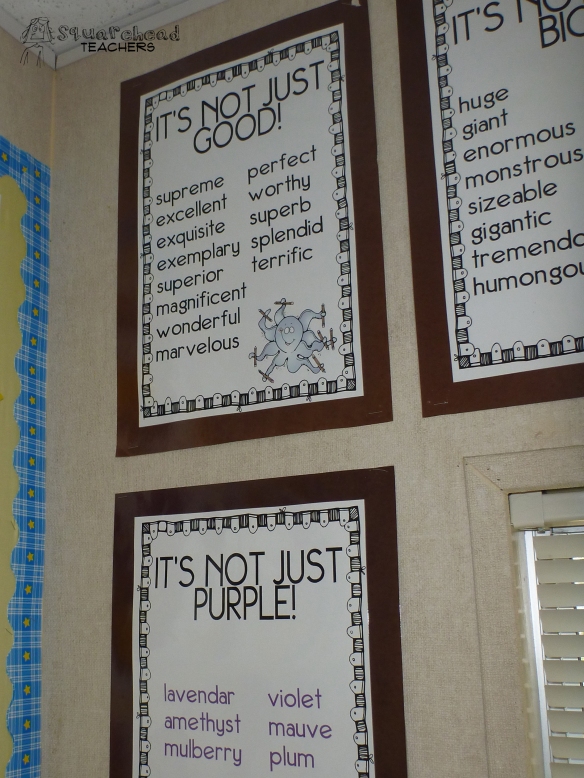Monthly Archives: August 2013
The Sprinkler Surprise (grammar worksheet)
Number of the Day (worksheet collection)
As far as educational worksheets go, I’m really picky with what I’ll spend money on. I searched and searched for a number of the day packet I liked, but I couldn’t find any that I was completely jazzed about (or was willing to pay the listed price). So I made my own. They’re aligned with the Common Core (for example, 2nd grade works on “100 more than” and “100 less than”) and best of all, they’re FREE!
Click here for the collection: number of the day collection
* Be sure you know what’s on each worksheet before choosing a number for the day. Some worksheets ask for “100 less than” and it would confuse younger grades if the number of the day was 17.
* The PDF presents the pages in order of difficulty, starting with the easiest. I didn’t number them, because I was afraid a student would think the worksheet number was the number of the day. I suggest printing them all off and labeling them with a sticky tab so you know what order they go in.
*Number 6 and 7 aren’t all that different. The only difference is one question clearly asks for multiplication, where as the previous 5 worksheets allow the option for repeated addition (double or triple the number).
I’ve also seen teachers do a number of the day on the whiteboard to help reinforce it even more:
It’s Not Just “Red”… It’s “Vermilion!” (Synonyms Group Activity)
 Teaching kids to use “good words” in their writing is hard. It’s not always easy to find a good synonym for “red” but this activity should help broaden their diction horizons. Divide your class into 10 groups. Pass out one color synonym sheet and a thesaurus to each group. Instruct each group to find as many synonyms for their color as possible. Then have them draw a border around their sheet using the color they searched. Post these somewhere in the room for a few days so students can browse the synonyms.
Teaching kids to use “good words” in their writing is hard. It’s not always easy to find a good synonym for “red” but this activity should help broaden their diction horizons. Divide your class into 10 groups. Pass out one color synonym sheet and a thesaurus to each group. Instruct each group to find as many synonyms for their color as possible. Then have them draw a border around their sheet using the color they searched. Post these somewhere in the room for a few days so students can browse the synonyms.
Click here for the PDF: synonyms- color collection
This same idea can be done with common nouns and adjectives such as “big,” “said,” “like,” “fast,” etc. Here are some photos of this idea being used in a classroom…
Top 10 Things New Teachers Should Know
 New teachers are often overwhelmed at the insane amount of things to balance and teach effectively. Here’s an article by Catherine Wilcoxson, Ph.D. of Northern Arizona University that helps new teachers stay focused on the important things.
New teachers are often overwhelmed at the insane amount of things to balance and teach effectively. Here’s an article by Catherine Wilcoxson, Ph.D. of Northern Arizona University that helps new teachers stay focused on the important things.
Here are the main ideas:
- Don’t worry so much about doing the right thing.
- Relax.
- Teaching is hard work.
- Standards cannot be ignored and should not be feared.
- Write objectives that focus on student learning, not on today’s task.
- Smile, and do so frequently
- Respect your students.
- Believe in your students even if they don’t believe in themselves.
- Don’t isolate yourself.
- It is not appropriate to teach the way we were taught
The whole article is a good read. It’ll take you 10 minutes or less to read, but it’s worth the time. Dr. Wilcoxson’s conclusion is that, “Effective teachers are constantly learning from their successes and failures. To be effective, teachers must look back on their practices and assess what works well, what doesn’t, and how they might improve as teachers. Keeping a journal is an excellent means of keeping track of your performance, and it can provide valuable information for your own professional development.”
Golfing Review Game
I recently saw this picture on Pinterest. I couldn’t follow the link very far, because I wasn’t a member of acvitityconnection.com, but I was inspired. Here’s my idea:

Set up: Make a box like this, with varying sized holes in the front. Smaller holes are worth more points. Then set it up in your classroom, with masking tape line on the ground, denoting where students should stand before they putt.
Game play: Group students for the review. Ask a review question, and have each team write down their answer. At the same time, have all groups reveal their answer. Any team who gets the answer right, gets to send 1 person to putt once to try to earn points. At the end of the game, the team with the most points wins!
I’ve tried numerous games like this with my 6h graders and they loved them! It disguised reviewing for the end of the year tests so the kids had a blast and we got through tons of math and science review questions!
Using Graphic Organizers to Sort Characteristics
I don’t know about you, but I love using graphic organizers. I’m a visual learner, so maybe that’s why. But anyway, this anchor chart I saw in an elementary school classroom seemed to be an effective way to study animals (spiders, in this case). It focuses on characteristics, sorted according to 3 verbs: are, can and have. It’s a very basic idea, but works well because students can just finish the sentence “Spiders have…” or “Spiders can…” to help them sort out and analyze characteristics. This same idea could be used for a variety of topics, simply by changing the 3 verbs used.
10 Tips for New Teachers
 I absolutely LOVED this article by Valerie Strauss. I totally wish I had read this before I started teaching! Ha!
I absolutely LOVED this article by Valerie Strauss. I totally wish I had read this before I started teaching! Ha!
1) Listen to advice (your mentor, teachers in the lounge, books for new teachers) — but trust your gut. Your goal is becoming an authentic teacher, one with autonomy, mastery and purpose. You will inevitably build a practice by stealing ideas from hundreds of people. The concepts you retain and embed into daily work are those that align and resonate with your core beliefs about education, which will change over time. Learn to trust the little interior voice that tells you what “works” for your colleague — her behavior rewards system based on Jolly Ranchers, say — may be totally wrong for you, in spite of the fact that her class walks quietly in a straight line and your kids are straggling and blabbing.
2) Don’t wear your really cool clothes to school. Don’t read articles like this, either, which suggest it’s easy or essential to find discounted designer items for your stylin’ school wardrobe. Your go-to daily wardrobe will consist of items that are comfortable, have pockets, do not reveal flesh (attractive or unattractive flesh) and are impervious to all bodily fluids and getting snagged on the pencil sharpener. Shoot for: neat, clean, kind of boring. Avoid: sexy, luxe, casual chic. Corollary: never store your designer purse in your desk drawer.
3) You’re the adult in the room. Don’t get into power struggles with students, where you feel compelled to come out ahead by cracking down (this applies to first-graders as well as seniors). Remind yourself: you’ve already won–you’re the teacher. You can afford to be magnanimous, to decide on outcomes that benefit all kids (even kids you don’t like), rather than gratifying your ever-present sense of control / retribution. You’re the adult. Repeat three times.
4) Watch other teachers teach. You will probably have to arrange this yourself. But do it, even if it means taking a fake sick day in November to watch colleagues in another school. Do it during your planning period, too. Good teachers will be flattered when you ask permission to sit in their classes for a half-hour. Once you watch a dozen other teachers, you’ll have a baseline for measuring your own successes and screw-ups, plus a basket of field-tested techniques.
5) Most important people to get on your side first: custodians. Make cleaning up at the end of the day a habit for students and yourself — out of genuine respect for custodians and their work. Keep your room tidy, and extend honest friendliness to cleaning staff. It’s good karma–and it means the custodian will hustle to your room when someone throws up.
6) Stuff is not teaching. I knew a teacher who had 25 pre-laminated, super-cute bulletin boards–which she kept filed, by month, in color-coded rolling crates. She did all her Xeroxing before school started. Her book baskets had perky bows and her door had gingham curtains. And her teaching was rote and sterile.
7) Don’t patronize teacher stores. Nobody needs expensive bulletin board borders or retail-priced “Good Job!!” stickers. Anything you find at a teacher store can be purchased for less, elsewhere — without cloying commercial images of school. Invite kids to answer questions on your (chart paper-covered) walls. Snag 75%-off calendars in February, then cut them apart as artwork displays. Buy Dora the Explorerbandaids to acknowledge emotional boo-boos or outstanding work (even HS freshmen love them), dollar-store scissors and remnant-bin books. Be funky, creative and cheap when stocking your classroom.
8) Set aside a weekly prep time. Extremely disciplined teachers might choose Friday afternoon, but the advantage of waiting until Sunday evening is that you can work with a glass of wine in hand, feet up in a recliner and awesome music playing. In 31 years of teaching, I never abandoned the Ritual of Sunday Night. The planning and prep work you do may evaporate by Tuesday, but knowing you’re all set when you arrive at school Monday morning is priceless.
9) Just as broken bones are stronger where they heal, fractured relationships with students can turn into improved communication with your whole class. You will undoubtedly have it out with certain students, over time. You’d be surprised how often they minimize incidents that haunt you for days. You’d also be surprised at how much they want to be on your good side, once you offer them the chance, in public–and how their classmates will respect your forgiving nature.
10) Expect to make hideous mistakes. Expect to have crushing disappointments. Expect to feel like quitting, at least a dozen times. Expect to anticipate vacations with pathetic longing. And know that veteran teachers also experience these things, Just ask them.
This was written by educator Nancy Flanagan for her Education Week Teacher blog, “Teacher in a Strange Land.” She spent 30 years in a K-12 music classroom in Hartland, Mich, and was named Michigan Teacher of the Year in 1993. She is National Board-certified, and a member of the Teacher Leaders Network. She is now an author and consultant.












